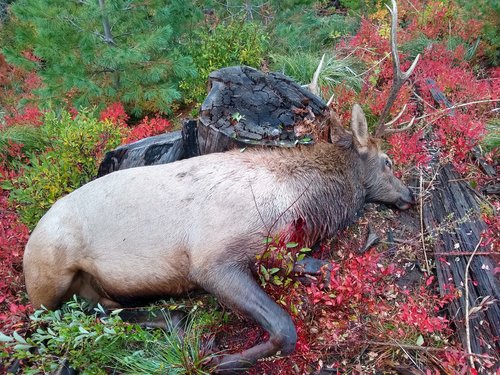D
Deleted member 28227
Guest
There are guys that are legit and then there are guys that think bull elk weigh 1,000 lbs.
Even 350 bulls do not weigh 1,000 lbs.
Don’t even get me started about bears...
Follow along with the video below to see how to install our site as a web app on your home screen.
Note: This feature may not be available in some browsers.
There are guys that are legit and then there are guys that think bull elk weigh 1,000 lbs.
Even 350 bulls do not weigh 1,000 lbs.
Heck, one guy I know went to Wyoming, shot a cow elk, and brought home 400 lbs of meat. Just ask him
We hung my 2008 NM bull from a tree and worked him up, filling two 120 qt coolers to the top with nothing but muscle. Drove to Prairie City OR and ol' man Huffman weighed the meat on the scales in the meat processor area of his market; 330 pounds. I haven't come close to that since.
With bears, I double what I think they are and add 50 pounds. Never weighed one but I think my method is pretty close.Don’t even get me started about bears...
With bears, I double what I think they are and add 50 pounds. Never weighed one but I think my method is pretty close.
Hmmm.
Is this the first year you have told the truth?I've been called a liar every year but this one, two months left.

The general consensus based on actual studies (University of Wyoming has done the most work in this area) is basically you end up with 1/3rd if the weight of the animal on the hoof (including guts, blood, etc.) in boneless meat.
This goes down on younger smaller animals and up on larger more mature animals but it is almost always in the 30 to 40 percent range.
Here in Texas I’ve been able to actually weigh a few animals (deer and pigs) before gutting them and those formulas were dead on for me.
Weighing a whole animal with an actual scale and guessing the weight based on heaving it around a bit are two drastically different things.
Definitely and I'm aware of the 30% rule, problem is that data point is totally irrelevant. People are so bad at estimating live weight it makes the whole estimating meat yield look reasonable. To talk to hunters, every spring bear killed in MT this year weighed 400lbs live, when in reality I bet 80% were less than 140lbs, 10% were 150-175lbs, 5% were 175-200lbs, and 5% were above 200lbs.
Randy11's moose at 436 X 3 = 1,308 live weight which seems reasonable for a mature bull moose.
I just use the 1/3rd rule to check believeability of the quoted number.
Liver was 3.5 lbs, each scapula was about 1.25 lbs, and I'd guess there was 10 lbs of tallow, so 62 -3.5 -2.5 -10 = 46 lbs. of meat. Mature does in IA are 140-160 lbs off the hoof LINK, which x 0.30 yields 42-48 lbs of meat. This doe was a typical specimen for the area.Not to call anyone out but the 62lbs off a whitetail doe would equal a 186 live weight which seems pushing the envelope, but then if you factor in liver, heart, scapula etc. that normally wouldn't be included say that is 10 pounds. Take that off the 62 pounds gets you to to 52 lbs of boneless meat not counting organs and that gets you up to 156 live weight which seems much more reasonable.
That 436 was with bone-in quarters, which with a moose those bones are probably a fairly significant amount of weight.